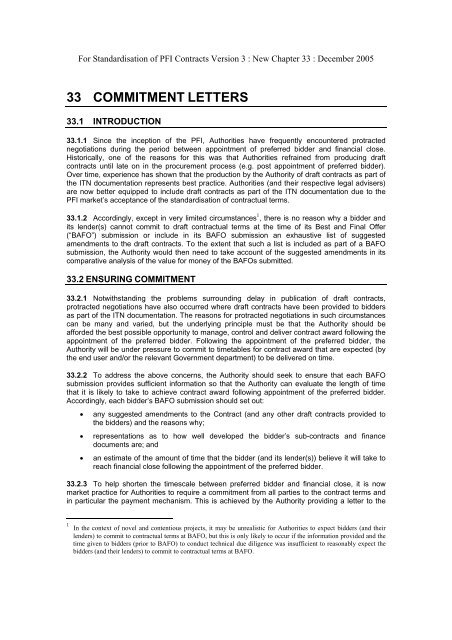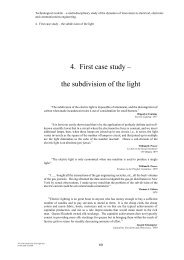Insurance Commitment Letter - HM Treasury
Insurance Commitment Letter - HM Treasury
Insurance Commitment Letter - HM Treasury
Create successful ePaper yourself
Turn your PDF publications into a flip-book with our unique Google optimized e-Paper software.
For Standardisation of PFI Contracts Version 3 : New Chapter 33 : December 2005<br />
33 COMMITMENT LETTERS<br />
33.1 INTRODUCTION<br />
33.1.1 Since the inception of the PFI, Authorities have frequently encountered protracted<br />
negotiations during the period between appointment of preferred bidder and financial close.<br />
Historically, one of the reasons for this was that Authorities refrained from producing draft<br />
contracts until late on in the procurement process (e.g. post appointment of preferred bidder).<br />
Over time, experience has shown that the production by the Authority of draft contracts as part of<br />
the ITN documentation represents best practice. Authorities (and their respective legal advisers)<br />
are now better equipped to include draft contracts as part of the ITN documentation due to the<br />
PFI market’s acceptance of the standardisation of contractual terms.<br />
33.1.2 Accordingly, except in very limited circumstances 1 , there is no reason why a bidder and<br />
its lender(s) cannot commit to draft contractual terms at the time of its Best and Final Offer<br />
(“BAFO”) submission or include in its BAFO submission an exhaustive list of suggested<br />
amendments to the draft contracts. To the extent that such a list is included as part of a BAFO<br />
submission, the Authority would then need to take account of the suggested amendments in its<br />
comparative analysis of the value for money of the BAFOs submitted.<br />
33.2 ENSURING COMMITMENT<br />
33.2.1 Notwithstanding the problems surrounding delay in publication of draft contracts,<br />
protracted negotiations have also occurred where draft contracts have been provided to bidders<br />
as part of the ITN documentation. The reasons for protracted negotiations in such circumstances<br />
can be many and varied, but the underlying principle must be that the Authority should be<br />
afforded the best possible opportunity to manage, control and deliver contract award following the<br />
appointment of the preferred bidder. Following the appointment of the preferred bidder, the<br />
Authority will be under pressure to commit to timetables for contract award that are expected (by<br />
the end user and/or the relevant Government department) to be delivered on time.<br />
33.2.2 To address the above concerns, the Authority should seek to ensure that each BAFO<br />
submission provides sufficient information so that the Authority can evaluate the length of time<br />
that it is likely to take to achieve contract award following appointment of the preferred bidder.<br />
Accordingly, each bidder’s BAFO submission should set out:<br />
• any suggested amendments to the Contract (and any other draft contracts provided to<br />
the bidders) and the reasons why;<br />
• representations as to how well developed the bidder’s sub-contracts and finance<br />
documents are; and<br />
• an estimate of the amount of time that the bidder (and its lender(s)) believe it will take to<br />
reach financial close following the appointment of the preferred bidder.<br />
33.2.3 To help shorten the timescale between preferred bidder and financial close, it is now<br />
market practice for Authorities to require a commitment from all parties to the contract terms and<br />
in particular the payment mechanism. This is achieved by the Authority providing a letter to the<br />
1 In the context of novel and contentious projects, it may be unrealistic for Authorities to expect bidders (and their<br />
lenders) to commit to contractual terms at BAFO, but this is only likely to occur if the information provided and the<br />
time given to bidders (prior to BAFO) to conduct technical due diligence was insufficient to reasonably expect the<br />
bidders (and their lenders) to commit to contractual terms at BAFO.
For Standardisation of PFI Contracts Version 3 : New Chapter 33 : December 2005<br />
preferred bidder, to be countersigned by the bidder, its lenders and subcontractors in which the<br />
parties confirm their acceptance of and commitment to the draft contracts contained in the ITN<br />
documentation. The letter will also set out any outstanding issues, which remain to be agreed<br />
between the parties. 2 Appointment of the preferred bidder will be conditional upon signature of<br />
the commitment letter. 3<br />
33.2.4 Whilst lenders are prepared to provide such letters, they typically vary in terms of<br />
commitment and often do not give the Authority the level of comfort that it is looking for.<br />
Accordingly, the Authority should include in the ITN documentation (or BAFO documentation if<br />
the ITN documentation did not include a form of commitment letter) the form of commitment letter<br />
that it will require the preferred bidder, its lenders and subcontractors to sign. Further guidance<br />
on how to apply the principles outlined above to funding competitions may be issued in the future<br />
and may supercede some of the above. Until such time as any such further guidance is issued,<br />
this section should be adhered to.<br />
33.3 REQUIRED APPROACH<br />
33.3.1 The form of commitment letter to be included in ITN documentation (or BAFO<br />
documentation if the ITN documentation did not include a form of commitment letter) to be<br />
countersigned by the preferred bidder, its lenders and subcontractors is set out below:<br />
[ON LETTERHEAD OF AUTHORITY]<br />
[Date]<br />
[Name and Address of Bidder]<br />
Dear [BIDDER CONTACT]<br />
[PROJECT HEADING]<br />
Following our letter to you of [ ] [and our subsequent conversations] I am writing to you to<br />
set out the position which has now been agreed between us.<br />
Subject to receiving confirmation from you and [LENDER] on the points addressed in this<br />
letter, the decision has been taken by the Authority to appoint [BIDDER] as preferred<br />
bidder.<br />
1. The unitary payments set out within your bid are fixed by reference to your design and<br />
services proposals (subject, of course, to any significant client changes) and on the<br />
assumption that financial close occurs on or before [•] (“ Expected Date of Financial<br />
Close”) . If financial close occurs after that date then your construction price will be<br />
increased only by movements in the [•] index from (but excluding) the Expected Date<br />
of Financial Close up to (but including) [•] and thereafter increased in accordance with<br />
your proposal included in [REFERENCE] of your Bid submission of [DATE]. The<br />
Authority will take the risk of any movement in [LIBOR][applicable interest rates]<br />
[relevant index] between [DATE OF BID SUBMISSION] and financial close. The<br />
benefit of any reduction in [LIBOR][applicable interest rates] [relevant index] (including<br />
the buffer) will be passed in full to the Authority.<br />
2 The list of outstanding issues will be based on the information provided in the preferred bidder’s BAFO submission.<br />
This will include any outstanding Senior Lender issues (e.g. areas of due diligence and credit committee approval).<br />
3<br />
The European Investment Bank may require the commitment letter to be in respect of the Project rather than the<br />
individual bidder.
For Standardisation of PFI Contracts Version 3 : New Chapter 33 : December 2005<br />
2. (a) Subject to paragraph (b) below the unitary payments set out within your bid as<br />
representing the price payable for taking out and maintaining the [Required<br />
<strong>Insurance</strong>s] as that term is used in the draft contract terms (“<strong>Insurance</strong> Costs”) is<br />
fixed up to and including the Expected Date of Financial Close. From but excluding the<br />
date of Expected Financial Close <strong>Insurance</strong> Costs may be increased but only to the<br />
extent required as a consequence of any increase in the sum insured following any<br />
increase in the construction price allowed in accordance with paragraph 1 above. Any<br />
adjustment will be at the following rate [Bidder to specify].<br />
(b) <strong>Insurance</strong> Costs may also be revised if (i) any risk to be insured under the Required<br />
<strong>Insurance</strong>s becomes Uninsurable (as such terms are used in the draft Contract terms,<br />
or (ii) following any significant client changes by the Authority to the scope of the<br />
project.<br />
3. As regards the draft contract terms, we are pleased that, [subject to the points<br />
discussed below], you have confirmed your acceptance to these terms. Again, we<br />
would ask for your confirmation by way of countersignature of this letter that, subject to<br />
the one point set out below, you have accepted the draft Project Contract [refer to<br />
version and date] [and [refer to other relevant project documents]] as issued to you, so<br />
that the only issues which will require negotiation between now and contract signature<br />
are matters of detail which are project-specific and which remain to be agreed.<br />
4. The issue(s) that remained to be agreed relate to [•] 4 .<br />
5. [As regards the draft payment mechanism, we would ask you to confirm; again by<br />
counter signature of this letter, that you have accepted the current draft in its entirety<br />
[subject only to [•]]].<br />
We should be grateful if you, [SUBCONTRACTORS] and [LENDER] would countersign this<br />
letter where indicated below to confirm your approval to the terms of this letter.<br />
Yours sincerely<br />
………………..<br />
[SIGNED ON BEHALF OF AUTHORITY]<br />
……………….. ………………..<br />
[SIGNED ON BEHALF OF BIDDER] [SIGNED ON BEHALF OF LENDER]<br />
………………..<br />
[SIGNED ON BEHALF OF SUBCONTRACTOR]<br />
4 Clearly this clause will not be included where there are no issues on the draft contracts. The resolution of any such<br />
issues shall have no effect on the <strong>Insurance</strong> Costs fixed under paragraphs 1 and 2.





![AIRTO [Professor Dr Brian Blunden] - HM Treasury](https://img.yumpu.com/15492848/1/184x260/airto-professor-dr-brian-blunden-hm-treasury.jpg?quality=85)










